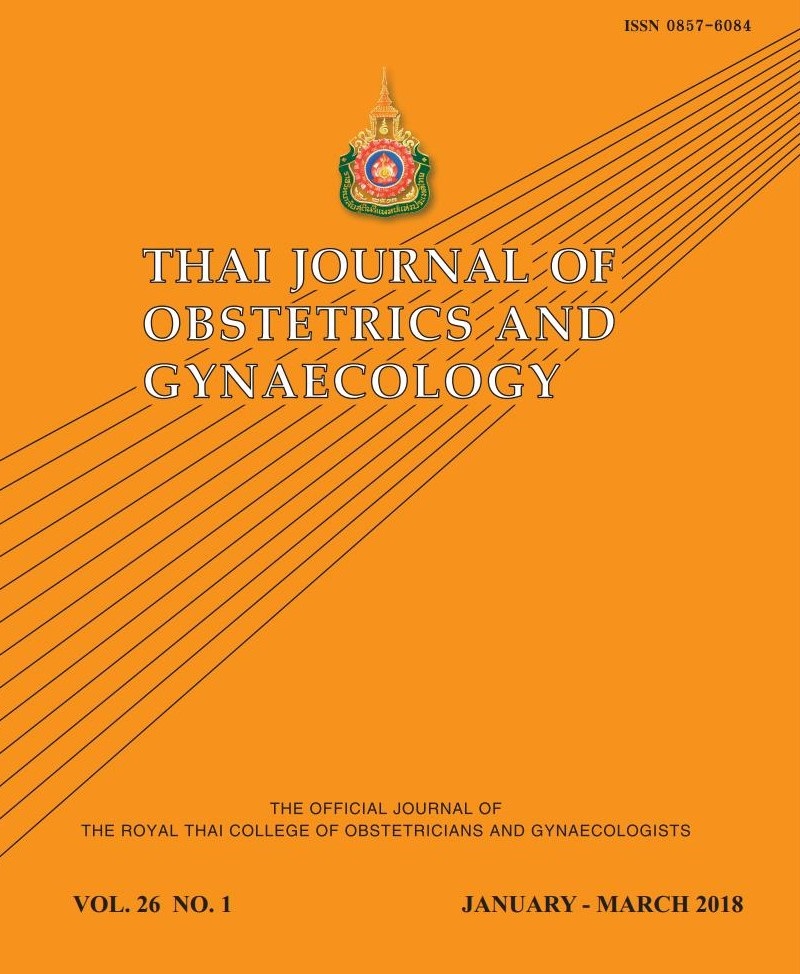Incidence of Intrapartum Abnormal Fetal Heart Rate Pattern in Siriraj Hospital
Main Article Content
Abstract
Objectives: To determine the incidence of intrapartum abnormal fetal heart rate (FHR), possible
associated factors and pregnancy outcomes.
Materials and Methods: A total of 900 low-risk pregnant women were enrolled in this retrospective
cohort study. Obstetric, labor and delivery data were collected. Incidence of intrapartum abnormal
FHR pattern was determined, according to the National Institute of Child Health and Human
Development (NICHD) classifiation. Comparisons were made between those with and without
abnormal FHR pattern to evaluate possible associated factors and pregnancy outcomes.
Results: Mean maternal age was 29.1 years, 55.7% were nulliparous, and mean gestational age at
delivery was 38.1 weeks. Incidence of abnormal FHR pattern was 30.7% (30.3% and 0.4% in
NICHD category II and III, respectively). Among these, 46.6% and 39.7% occurred in active
and deceleration phase of labor, respectively. Univariate analysis showed that rate of abnormal
FHR pattern was more common among nulliparous women (RR 1.22, 95% CI 1.003-1.5,
p = 0.045). Cesarean delivery was required in 28.9% of cases with abnormal FHR pattern. Birth
asphyxia was signifiantly more common among those with abnormal FHR pattern (7.2% vs.
3.7%, p = 0.016). Multivariate analysis demonstrated that only nulliparity was signifiantly
associated with abnormal FHR pattern (adjusted OR 1.35, 95%CI 1.01-1.82, p = 0.045).
Conclusion: Incidence of intrapartum abnormal FHR pattern was 30.7% and nulliparity was the only
independent associated factor. The condition signifiantly increased the risk of birth asphyxia.
Keywords: abnormal fetal heart rate pattern, electronic fetal monitoring, incidence, nulliparity
Article Details
References
2. Macones GA, Hankins GD, Spong CY, Hauth J, Moore T. The 2008 National Institute of Child Health and Human Development workshop report on electronic fetal monitoring: update on definitions, interpretation, and research guidelines. Obstet Gynecol 2008;112:661-6.
3. American College of Obstetricians and Gynecologists. ACOG Practice Bulletin No. 106: Intrapartum fetal heart rate monitoring: nomenclature, interpretation, and general management principles. Obstet Gynecol 2009;114:192-202.
4. American College of Obstetricians and Gynecologists. Practice bulletin no. 116: Management of intrapartum fetal heart rate tracings. Obstet Gynecol 2010;116:1232-40.
5. Clark SL, Nageotte MP, Garite TJ, Freeman RK, Miller DA, Simpson KR, et al. Intrapartum management of category II fetal heart rate tracings: towards standardization of care. Am J Obstet Gynecol 2013;209:89-97.
6. Hankins GD, Miller DA. A review of the 2008 NICHD Research Planning Workshop: recommendations for fetal heart rate terminology and interpretation. Clin Obstet Gynecol 2011;54:3-7.
7. Fahey JO. The recognition and management of intrapartum fetal heart rate emergencies: beyond definitions and classification. J Midwifery Womens Health 2014;59:616-23.
8. Jackson M, Holmgren CM, Esplin MS, Henry E, Varner MW. Frequency of fetal heart rate categories and short-term neonatal outcome. Obstet Gynecol 2011;118:803-8.
9. Salim R, Garmi G, Nachum Z, Shalev E. The impact of non-significant variable decelerations appearing in the latent phase on delivery mode: a prospective cohort study. Reprod Biol Endocrinol 2010;8:81.
10. Aldrich CJ, D’Antona D, Spencer JA, Wyatt JS, Peebles DM, Delpy DT, et al. Late fetal heart decelerations and changes in cerebral oxygenation during the first stage of labour. BJOG 1995;102:9-13.
11. Fleischer A, Schulman H, Jagani N, Mitchell J, Randolph G. The development of fetal acidosis in the presence of an abnormal fetal heart rate tracing. I. The average for gestational age fetus. Am J Obstet Gynecol 1982;144:55-60.
12. Hadar A, Sheiner E, Hallak M, Katz M, Mazor M, Shoham-Vardi I. Abnormal fetal heart rate tracing patterns during the first stage of labor: effect on perinatal outcome. Am J Obstet Gynecol 2001;185:863-8.
13. Krebs HB, Petres RE, Dunn LJ, Jordaan HV, Segreti A. Intrapartum fetal heart rate monitoring. III. Association of meconium with abnormal fetal heart rate patterns. Am J Obstet Gynecol 1980;137:936-43.
14. Steer PJ, Eigbe F, Lissauer TJ, Beard RW. Interrelationships among abnormal cardiotocograms in labor, meconium staining of the amniotic fluid, arterial cord blood pH, and Apgar scores. Obstet Gynecol 1989;74:715-21.
15. Chauhan SP, Magann EF, Scott JR, Scardo JA, Hendrix NW, Martin JN, Jr. Cesarean delivery for fetal distress: rate and risk factors. Obstet Gynecol Surv 2003;58:337-50.
16. Leung TY, Lao TT. Timing of caesarean section according to urgency. Best Pract Res Clin Obstet Gynecol 2013;27:251-67.
17. Seitchik J, Holden AE, Castillo M. Spontaneous rupture of the membranes, functional dystocia, oxytocin treatment, and the route of delivery. Am J Obstet Gynecol 1987;156:125-30.
18. Zhang J, Troendle J, Reddy UM, Laughon SK, Branch DW, Burkman R, et al. Contemporary cesarean delivery practice in the United States. Am J Obstet Gynecol 2010;203:326.e1-.e10.


